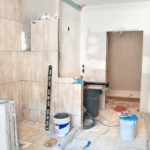How We Handle the Most Hazardous Water Damage Events
Category 3 water, also called “black water,” is the most severe class of water damage. It can come from sewage backups, floodwaters, or contaminated groundwater. It contains harmful bacteria, viruses, and chemicals. In St. Louis, heavy rains and sewer overflows are common causes of flooding. Due to the health risks, cleanup necessitates specialized equipment, stringent safety protocols, and adherence to local disposal regulations.
PPE: The First Line of Defense
Our team never enters a Category 3 site without full personal protective equipment (PPE). This includes impermeable coveralls, nitrile gloves, chemical-resistant boots, and a full-face respirator with P100 or equivalent filtration. For high-exposure areas, we also use powered air-purifying respirators. These devices protect our technicians from airborne contaminants, splashes, and skin contact.
Containment and Cross-Contamination Control
Stopping contamination spread is critical. We install physical barriers such as ZipWall magnetic dust barriers to isolate the affected area. Negative air machines equipped with HEPA filtration run continuously to keep airborne pathogens from migrating into clean areas. Entry and exit points are controlled to ensure that equipment and waste are removed without contaminating other parts of the property.
Disinfection and Antimicrobial Treatment
After water extraction, we remove all unsalvageable materials in line with local disposal regulations. Remaining surfaces are cleaned and treated with EPA-registered disinfectants. We often use Disinfectant Spray Plus or Benefect Botanical Decon 30, depending on the site’s needs. These products kill a broad range of bacteria, viruses, and fungi, reducing the risk of secondary mold growth. Application methods include pump sprayers, foaming systems, or fogging for hard-to-reach spaces.
Disposal Compliance
Contaminated building materials and debris are double-bagged in 6-mil polyethylene and sealed before transport. Disposal is conducted in accordance with Missouri’s environmental and waste management regulations, including the proper manifesting and use of approved landfill sites for hazardous materials. Liquid waste is never discharged into storm drains or unapproved locations.
Why Professional Handling Matters
Category 3 cleanup is not just about drying the structure. It is about restoring it to a safe condition. Skipping steps in PPE, containment, or disinfection can leave dangerous pathogens behind. Our approach meets and often exceeds IICRC S500 and S520 industry standards.
If you suspect Category 3 water damage, call us immediately. Sansara 24/7 Restoration & Remodeling – (636) 812-3838 – Serving St. Louis and surrounding areas.



